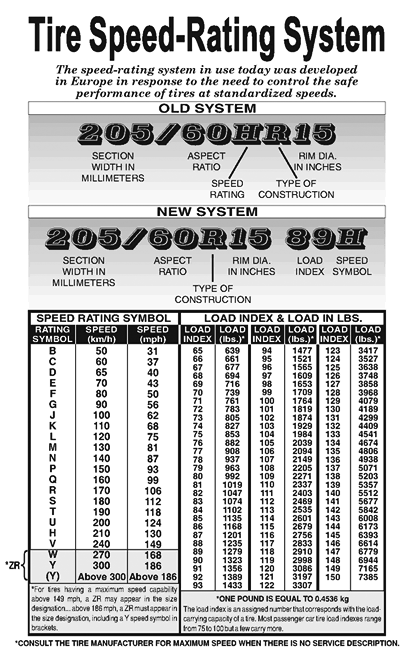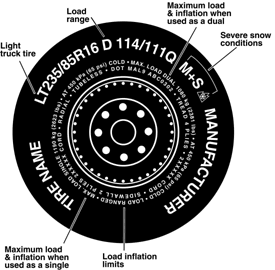This will help you to understand all those confusing numbers and letters that are placed on the sidewalls of tires.
Passenger, Truck, & Speed Ratings.


 (click links to expand)
(click links to expand)
[B]
Uniform Tire Quality Grading System (UTQGS)[B]
TREADWEAR
Treadwear grades are an indication of a tire's relative wear rate. The higher the treadwear number is, the longer it should take for the tread to wear down.
A control tire is assigned a grade of 100. Other tires are compared to the control tire. For example, a tire grade of 200 should wear twice as long as the control tire.
Of current tires:
15% are rated below 200
25% are rated 201 - 300
32% are rated 301 - 400
20% are rated 401 - 500
6% are rated 501 - 600
2% are rated above 600
TRACTION
Traction grades are an indication of a tire's ability to stop on wet pavement. A higher graded tire should allow a car to stop on wet roads in a shorter distance than a tire with a lower grade. Traction is graded from highest to lowest as "AA", "A", "B", and "C".
Of current tires:
3% are rated "AA"
75% are rated "A"
22% are rated "B"
only 1 line of tires rated "C"
TEMPERATURE
Temperature grades are an indication of a tire's resistance to heat. Sustained high temperature (for example, driving long distances in hot weather), can cause a tire to deteriorate, leading to blowouts and tread separation. From highest to lowest, a tire's resistance to heat is graded as "A", "B", or "C".
Of current tires:
A, B C, represent a tire's resistance to heat and its ability to dissipate heat when tested under controlled laboratory test conditions. The grades from highest to lowest are "A","B" and "C". The grade "C" corresponds to the minimum performance required by federal safety standard. Therefore, the "A" tire is the coolest running, and even though the "C" tire runs hotter it does not mean it is unsafe. The temperature grade is established for a tire that is properly inflated and not overloaded.
Bookmarks